Co-Benefits Analysis of Coal De-Capacity in China
Abstract
:1. Introduction
2. Materials and Methods
2.1. Overall Framework
2.2. Accounting for Coal De-Capacity
2.3. Development of the Coal’s Full Life Cycle Carbon Emission Inventory
2.4. Accounting for Air Pollutant Emissions
2.5. Health Impact Assessment Model
3. Results
3.1. Coal De-Capacity Feature
3.2. Spatial and Temporal Patterns of Carbon Emission Reductions
3.3. Response Concentrations of PM2.5 Pollutants
3.4. Health Co-Benefits
4. Discussion
5. Conclusions
Supplementary Materials
Author Contributions
Funding
Institutional Review Board Statement
Informed Consent Statement
Data Availability Statement
Acknowledgments
Conflicts of Interest
References
- Mukherji, A.; Thorne, P.; Cheung, W.W.L.; Connors, S.L.; Garschagen, M.; Geden, O.; Hayward, B.; Simpson, N.P.; Totin, E.; Blok, K.; et al. Synthesis Report of the IPCC Sixth Assessment Report (AR6); IPCC: Geneva, Switzerland, 2022. [Google Scholar]
- United Nations. Transforming Our World: The 2030 Agenda for Sustainable Development; United Nations: New York, NY, USA, 2016. [Google Scholar]
- Wood, G. The Palgrave Handbook of Managing Fossil Fuels and Energy Transitions; Wood, G., Baker, K., Eds.; Springer International Publishing: Cham, Switzerland; Palgrave Macmillan: London, UK, 2020. [Google Scholar]
- Singh, S. Energy Crisis and Climate Change: Global Concerns and Their Solutions. In Energy; Singh, P., Singh, S., Kumar, G., Baweja, P., Eds.; Wiley: Hoboken, NJ, USA, 2021; pp. 1–17. [Google Scholar]
- BP. Statistical Review of World Energy 2022; BP p.l.c.: London, UK, 2022. [Google Scholar]
- Ministry of Ecology and Environment of the People’s Republic of China. Report on the State of the Ecology and Environment in China 2021; Ministry of Ecology and Environment of the People’s Republic of China: Beijing, China, 2022.
- Bosikov, I.I.; Martyushev, N.V.; Klyuev, R.V.; Savchenko, I.A.; Kukartsev, V.V.; Kukartsev, V.A.; Tynchenko, Y.A. Modeling and Complex Analysis of the Topology Parameters of Ventilation Networks When Ensuring Fire Safety While Developing Coal and Gas Deposits. Fire 2023, 6, 95. [Google Scholar] [CrossRef]
- Miao, D.; Lv, Y.; Yu, K.; Liu, L.; Jiang, J. Research on Coal Mine Hidden Danger Analysis and Risk Early Warning Technology Based on Data Mining in China. Process Saf. Environ. Prot. 2023, 171, 1–17. [Google Scholar] [CrossRef]
- Lin, G.; Jiang, D.; Fu, J.; Dong, D.; Sun, W.; Li, X. Spatial Relationships of Water Resources with Energy Consumption at Coal Mining Operations in China. Mine Water Environ. 2020, 39, 407–415. [Google Scholar] [CrossRef]
- Ma, Q.; Wu, J.; He, C.; Fang, X. The Speed, Scale, and Environmental and Economic Impacts of Surface Coal Mining in the Mongolian Plateau. Resour. Conserv. Recycl. 2021, 173, 105730. [Google Scholar] [CrossRef]
- Chen, L.; Zhang, H.; Zhang, X.; Liu, P.; Zhang, W.; Ma, X. Vegetation Changes in Coal Mining Areas: Naturally or Anthropogenically Driven? CATENA 2022, 208, 105712. [Google Scholar] [CrossRef]
- Feng, Y.; Wang, J.; Bai, Z.; Reading, L. Effects of Surface Coal Mining and Land Reclamation on Soil Properties: A Review. Earth-Sci. Rev. 2019, 191, 12–25. [Google Scholar] [CrossRef]
- State Council of the People’s Republic of China. Opinions on the Coal Industry to Resolve Excess Capacity and Achieve Development; State Council of the People’s Republic of China: Beijing, China, 2016.
- Hao, X.; Song, M.; Feng, Y.; Zhang, W. De-Capacity Policy Effect on China’s Coal Industry. Energies 2019, 12, 2331. [Google Scholar] [CrossRef]
- Diluiso, F.; Walk, P.; Manych, N.; Cerutti, N.; Chipiga, V.; Workman, A.; Ayas, C.; Cui, R.Y.; Cui, D.; Song, K.; et al. Coal Transitions—Part 1: A Systematic Map and Review of Case Study Learnings from Regional, National, and Local Coal Phase-out Experiences. Environ. Res. Lett. 2021, 16, 113003. [Google Scholar] [CrossRef]
- Jakob, M.; Steckel, J.C. The Political Economy of Coal: Obstacles to Clean Energy Transitions, 1st ed.; Routledge: London, UK, 2022; ISBN 978-1-00-304454-3. [Google Scholar]
- Li, J.; Cai, W.; Li, H.; Zheng, X.; Zhang, S.; Cui, X.; Zhang, Y.; Cao, C.; Sun, R.; Wang, C. Incorporating Health Cobenefits in Decision-Making for the Decommissioning of Coal-Fired Power Plants in China. Environ. Sci. Technol. 2020, 54, 13935–13943. [Google Scholar] [CrossRef]
- Rauner, S.; Bauer, N.; Dirnaichner, A.; Dingenen, R.V.; Mutel, C.; Luderer, G. Coal-Exit Health and Environmental Damage Reductions Outweigh Economic Impacts. Nat. Clim. Chang. 2020, 10, 308–312. [Google Scholar] [CrossRef]
- Tong, D.; Geng, G.; Zhang, Q.; Cheng, J.; Qin, X.; Hong, C.; He, K.; Davis, S.J. Health Co-Benefits of Climate Change Mitigation Depend on Strategic Power Plant Retirements and Pollution Controls. Nat. Clim. Chang. 2021, 11, 1077–1083. [Google Scholar] [CrossRef]
- Tang, R.; Zhao, J.; Liu, Y.; Huang, X.; Zhang, Y.; Zhou, D.; Ding, A.; Nielsen, C.P.; Wang, H. Air Quality and Health Co-Benefits of China’s Carbon Dioxide Emissions Peaking before 2030. Nat. Commun. 2022, 13, 1008. [Google Scholar] [CrossRef] [PubMed]
- Markandya, A.; Sampedro, J.; Smith, S.J.; Van Dingenen, R.; Pizarro-Irizar, C.; Arto, I.; González-Eguino, M. Health Co-Benefits from Air Pollution and Mitigation Costs of the Paris Agreement: A Modelling Study. Lancet Planet. Health 2018, 2, e126–e133. [Google Scholar] [CrossRef]
- Chen, C.; Xue, B.; Cai, G.; Thomas, H.; Stückrad, S. Comparing the Energy Transitions in Germany and China: Synergies and Recommendations. Energy Rep. 2019, 5, 1249–1260. [Google Scholar] [CrossRef]
- He, G.; Lin, J.; Zhang, Y.; Zhang, W.; Larangeira, G.; Zhang, C.; Peng, W.; Liu, M.; Yang, F. Enabling a Rapid and Just Transition Away from Coal in China. One Earth 2020, 3, 187–194. [Google Scholar] [CrossRef] [PubMed]
- Liu, Z.; Guan, D.; Wei, W.; Davis, S.J.; Ciais, P.; Bai, J.; Peng, S.; Zhang, Q.; Hubacek, K.; Marland, G.; et al. Reduced Carbon Emission Estimates from Fossil Fuel Combustion and Cement Production in China. Nature 2015, 524, 335–338. [Google Scholar] [CrossRef]
- Wang, J. Evaluation of the Suitability of Energy Plant Production and Development on Marginal Land in the Three Gorges Reservoir Area. Master’s Thesis, Southwest University, Chongqing, China, 2018. [Google Scholar]
- Tang, L.; Qu, J.; Mi, Z.; Bo, X.; Chang, X.; Anadon, L.D.; Wang, S.; Xue, X.; Li, S.; Wang, X.; et al. Substantial Emission Reductions from Chinese Power Plants after the Introduction of Ultra-Low Emissions Standards. Nat. Energy 2019, 4, 929–938. [Google Scholar] [CrossRef]
- Bo, X.; Jia, M.; Xue, X.; Tang, L.; Mi, Z.; Wang, S.; Cui, W.; Chang, X.; Ruan, J.; Dong, G.; et al. Effect of Strengthened Standards on Chinese Ironmaking and Steelmaking Emissions. Nat. Sustain. 2021, 4, 811–820. [Google Scholar] [CrossRef]
- Tang, L.; Ruan, J.; Bo, X.; Mi, Z.; Wang, S.; Dong, G.; Davis, S.J. Plant-Level Real-Time Monitoring Data Reveal Substantial Abatement Potential of Air Pollution and CO2 in China’s Cement Sector. One Earth 2022, 5, 892–906. [Google Scholar] [CrossRef]
- Tibrewal, K.; Venkataraman, C. Climate Co-Benefits of Air Quality and Clean Energy Policy in India. Nat. Sustain. 2020, 4, 305–313. [Google Scholar] [CrossRef]
- Wu, H.; Wang, Q.; Xu, Y.; Ye, Y.; Zeng, X. Coal Life-Cycle Analysis Embedded with Land–Energy Nexus of a Coal-Based City in China. Resour. Environ. Sustain. 2023, 12, 100109. [Google Scholar] [CrossRef]
- Cao, C.; Cui, X.; Cai, W.; Wang, C.; Xing, L.; Zhang, N.; Shen, S.; Bai, Y.; Deng, Z. Incorporating Health Co-Benefits into Regional Carbon Emission Reduction Policy Making: A Case Study of China’s Power Sector. Appl. Energy 2019, 253, 113498. [Google Scholar] [CrossRef]
- Burnett, R.T.; Pope, C.A.; Ezzati, M.; Olives, C.; Lim, S.S.; Mehta, S.; Shin, H.H.; Singh, G.; Hubbell, B.; Brauer, M.; et al. An Integrated Risk Function for Estimating the Global Burden of Disease Attributable to Ambient Fine Particulate Matter Exposure. Environ. Health Perspect 2014, 122, 397–403. [Google Scholar] [CrossRef] [PubMed]
- Hui, J. Research on the Health Impact of Low Carbon Development Based on China’s Provincial Level Power Sector Optimization Model. Ph.D. Thesis, Tsinghua University, Beijing, China, 2018. [Google Scholar]
- Xinhua News Agency. Xi Jinping ’s Speech in the General Debate of the Seventy-Fifth United Nations General Assembly; Xinhua News Agency: Beijing, China, 2020. [Google Scholar]
- Wang, P.; Lin, C.-K.; Wang, Y.; Liu, D.; Song, D.; Wu, T. Location-Specific Co-Benefits of Carbon Emissions Reduction from Coal-Fired Power Plants in China. Nat. Commun. 2021, 12, 6948. [Google Scholar] [CrossRef] [PubMed]
- Wang, N.; Shen, R.; Wen, Z.; De Clercq, D. Life Cycle Energy Efficiency Evaluation for Coal Development and Utilization. Energy 2019, 179, 1–11. [Google Scholar] [CrossRef]
- International Energy Agency. Coal 2022—Analysis; International Energy Agency: Paris, France, 2022. [Google Scholar]
- Ministry of Ecology and Environment of the People’s Republic of China; National Development and Reform Commission of the People’s Republic of China; National Energy Adminis of the People’s Republic of Chinatration. Work Plan of Full Implementing Ultra-Low Emission Policy and Energy Saving Transformation for Coal-Fired Power Plants; Ministry of Ecology and Environment of the People’s Republic of China: Beijing, China, 2015.
- Balakrishnan, V.S. Germany’s Delayed Coal Phase-out and Respiratory Health. Lancet Respir. Med. 2018, 6, 90–91. [Google Scholar] [CrossRef] [PubMed]
- Brauers, H.; Oei, P.-Y.; Walk, P. Comparing Coal Phase-out Pathways: The United Kingdom’s and Germany’s Diverging Transitions. Environ. Innov. Soc. Transit. 2020, 37, 238–253. [Google Scholar] [CrossRef] [PubMed]
- Zhang, R.; Qie, X.; Hu, Y.; Chen, X. Does De-Capacity Policy Promote the Efficient and Green Development of the Coal Industry? –Based on the Evidence of China. Resour. Policy 2022, 77, 102717. [Google Scholar] [CrossRef]
- National Development and Reform Commission of the People’s Republic of China. Contribution of Coal Use to China’s Air Pollution; National Development and Reform Commission of the People’s Republic of China: Beijing, China, 2014.
- Zhou, M.; Wang, H.; Zeng, X.; Yin, P.; Zhu, J.; Chen, W.; Li, X.; Wang, L.; Wang, L.; Liu, Y.; et al. Mortality, Morbidity, and Risk Factors in China and Its Provinces, 1990–2017: A Systematic Analysis for the Global Burden of Disease Study 2017. Lancet 2019, 394, 1145–1158. [Google Scholar] [CrossRef]
- Cai, W.; Zhang, C.; Zhang, S.; Ai, S.; Bai, Y.; Bao, J.; Chen, B.; Chang, N.; Chen, H.; Cheng, L.; et al. The 2021 China Report of the Lancet Countdown on Health and Climate Change: Seizing the Window of Opportunity. Lancet Public Health 2021, 6, e932–e947. [Google Scholar] [CrossRef]
- Zinke, L. Decommissioning Coal. Nat. Rev. Earth Environ. 2020, 1, 626. [Google Scholar] [CrossRef]
- Kroll, C.; Warchold, A.; Pradhan, P. Sustainable Development Goals (SDGs): Are We Successful in Turning Trade-Offs into Synergies? Palgrave Commun. 2019, 5, 1–11. [Google Scholar] [CrossRef]
- Peng, W.; Wagner, F.; Ramana, M.V.; Zhai, H.; Small, M.J.; Dalin, C.; Zhang, X.; Mauzerall, D.L. Managing China’s Coal Power Plants to Address Multiple Environmental Objectives. Nat. Sustain. 2018, 1, 693–701. [Google Scholar] [CrossRef]
- Lin, G.; Fu, J.; Jiang, D.; Zhao, Y. Analysis of Water Synergy Benefits of Coal De-Capacity in China. Coal Sci. Technol. 2023, 51, 1–10. [Google Scholar]
- Bridle, R.; Kitson, L.; Duan, H.; Sanchez, L.; Merrill, T. At the Crossroads: Balancing the Financial and Social Costs of Coal Transition in China; International Institute for Sustainable Development: Winnipeg, MB, Canada, 2017. [Google Scholar]
- Andrews-Speed, P. China’s Efforts to Constrain Its Fossil Fuel Consumption. In The Palgrave Handbook of Managing Fossil Fuels and Energy Transitions; Springer International Publishing: Cham, Switzerland; Palgrave Macmillan: London, UK, 2019; pp. 109–137. [Google Scholar]
- Owusu, P.A.; Asumadu-Sarkodie, S. A Review of Renewable Energy Sources, Sustainability Issues and Climate Change Mitigation. Cogent Eng. 2016, 3, 1167990. [Google Scholar] [CrossRef]
- Liang, Y.; Yu, B.; Wang, L. Costs and Benefits of Renewable Energy Development in China’s Power Industry. Renew. Energy 2019, 131, 700–712. [Google Scholar] [CrossRef]
- Lin, G.; Zhao, Y.; Fu, J.; Jiang, D. Renewable Energy in China’s Abandoned Mines. Science 2023, 380, 699–700. [Google Scholar] [CrossRef]
- GB/T 2589-2020; State Administration for Market Regulation General Rules for Calculation of the Comprehensive Energy Consumption. Standardization Administration of PRC, Standards Press of China: Beijing, China, 2020.
- Ma, C.; Dai, E.; Liu, Y.; Wang, Y.; Wang, F. Methane fugitive emissions from coal mining and post-mining activities in China. Resour. Sci. 2020, 42, 311–322. [Google Scholar] [CrossRef]
- Cui, X. Carbon emission calculation of China’s coal industry. Energy Conserv. 2022, 5, 33–35+73. [Google Scholar]
- Wu, J.; Zhang, Y.; Tian, Y.; Xie, K. Analysis on carbon emission based on the life cycle of new coal chemical industry. Strateg. Study CAE 2015, 17, 69–74. [Google Scholar]
- Yin, Z. Research on Carbon Emission Accounting and Reduction Pathways for Coal Products. Master’s Thesis, Capital University of Economics and Business, Beijing, China, 2015. [Google Scholar]
- Gao, J.; Xu, X.; Zheng, F.; Huo, R. Coal carbon emission inventory calculation and uncertainties analysis based on lifecycle analysis. China Coal 2017, 43, 22–26. [Google Scholar] [CrossRef]
- He, J.; Wu, W.; Xu, Y. Energy consumption of locomotives in China railways during 1975–2007. J. Transp. Syst. Eng. Inf. Technol. 2010, 10, 22–27. [Google Scholar] [CrossRef]
- National Bureau of Statistics of the People’s Republic of Chin China Statistical Yearbook-2022; China Statistics Press: Beijing, China, 2023.
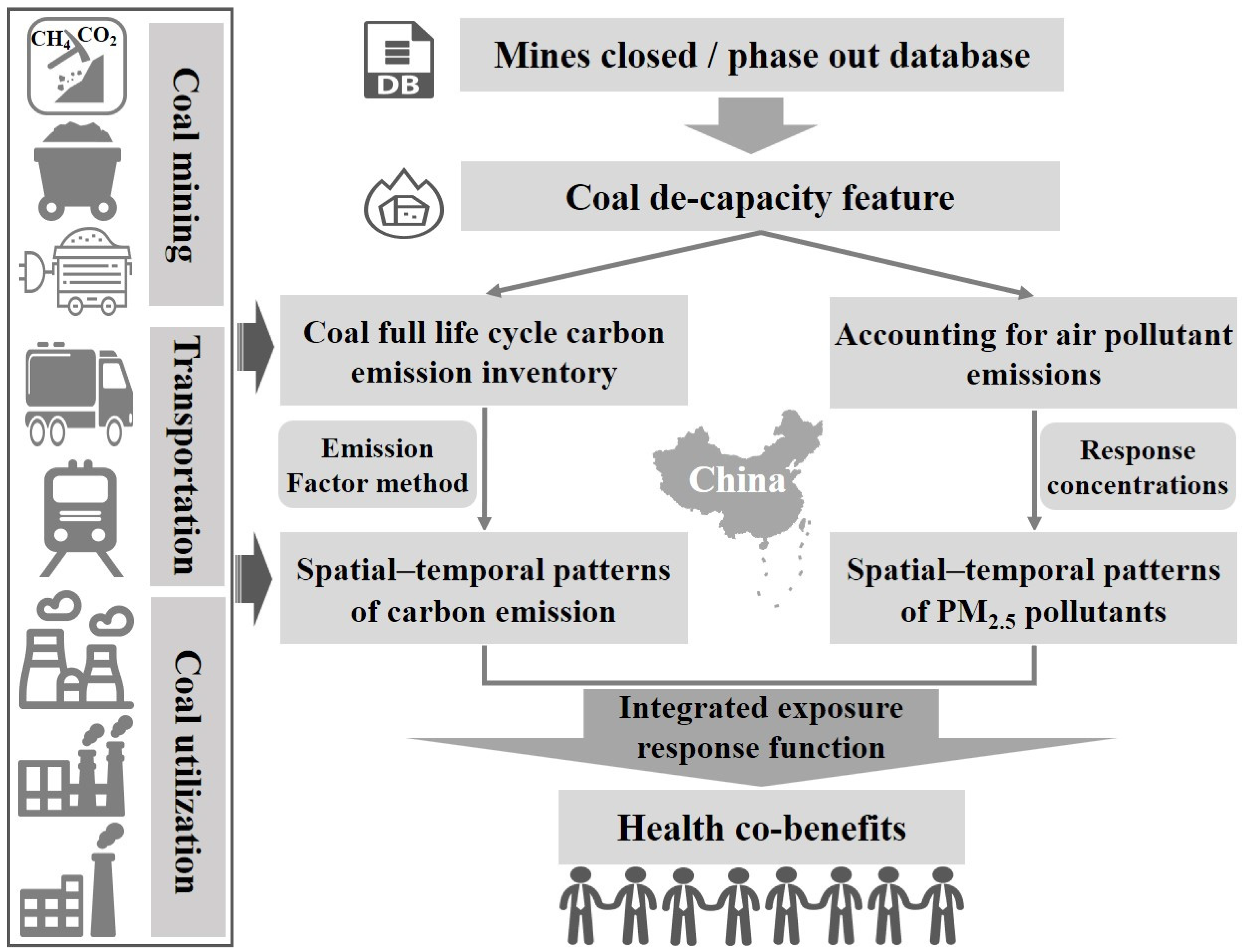
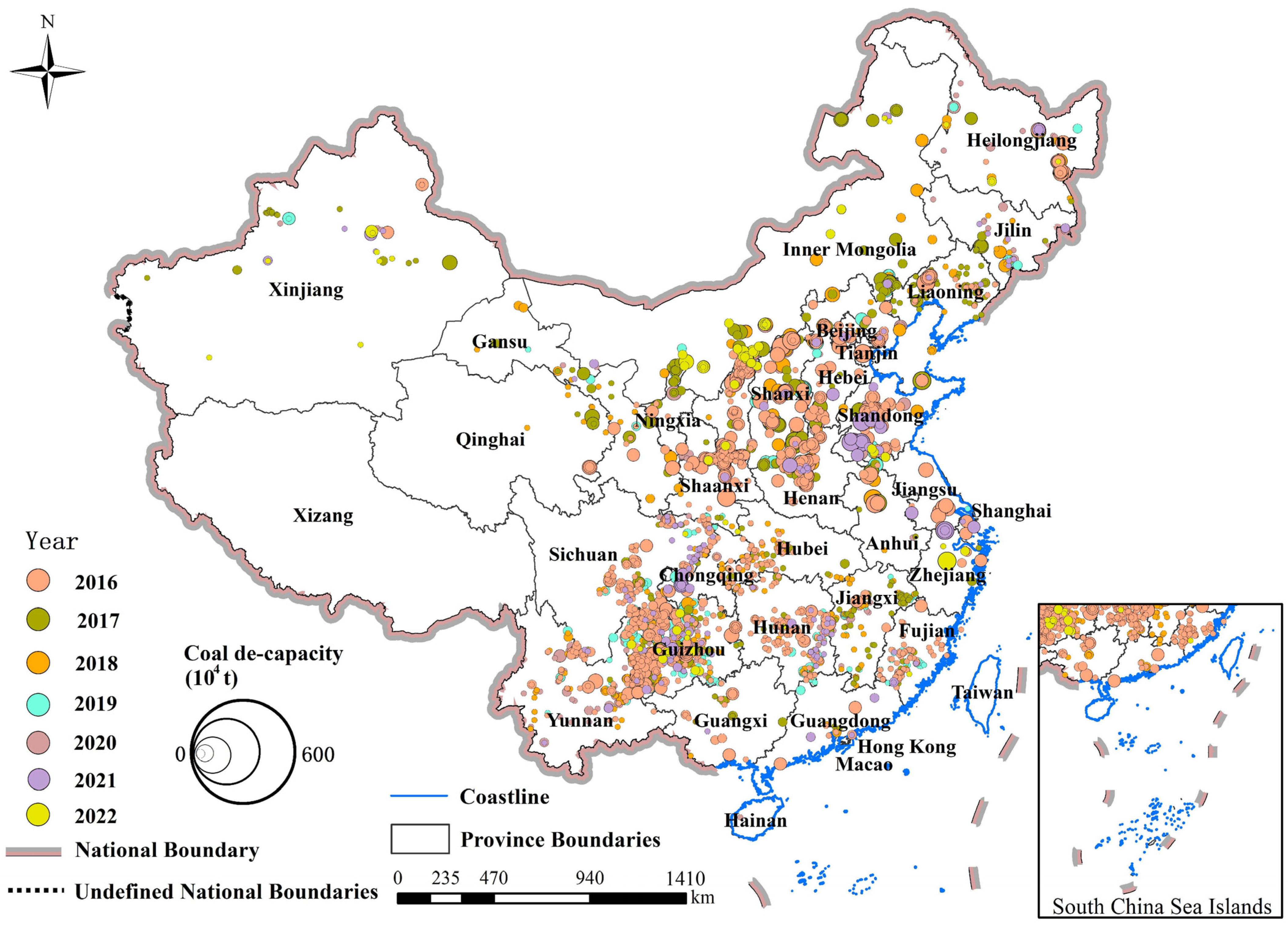
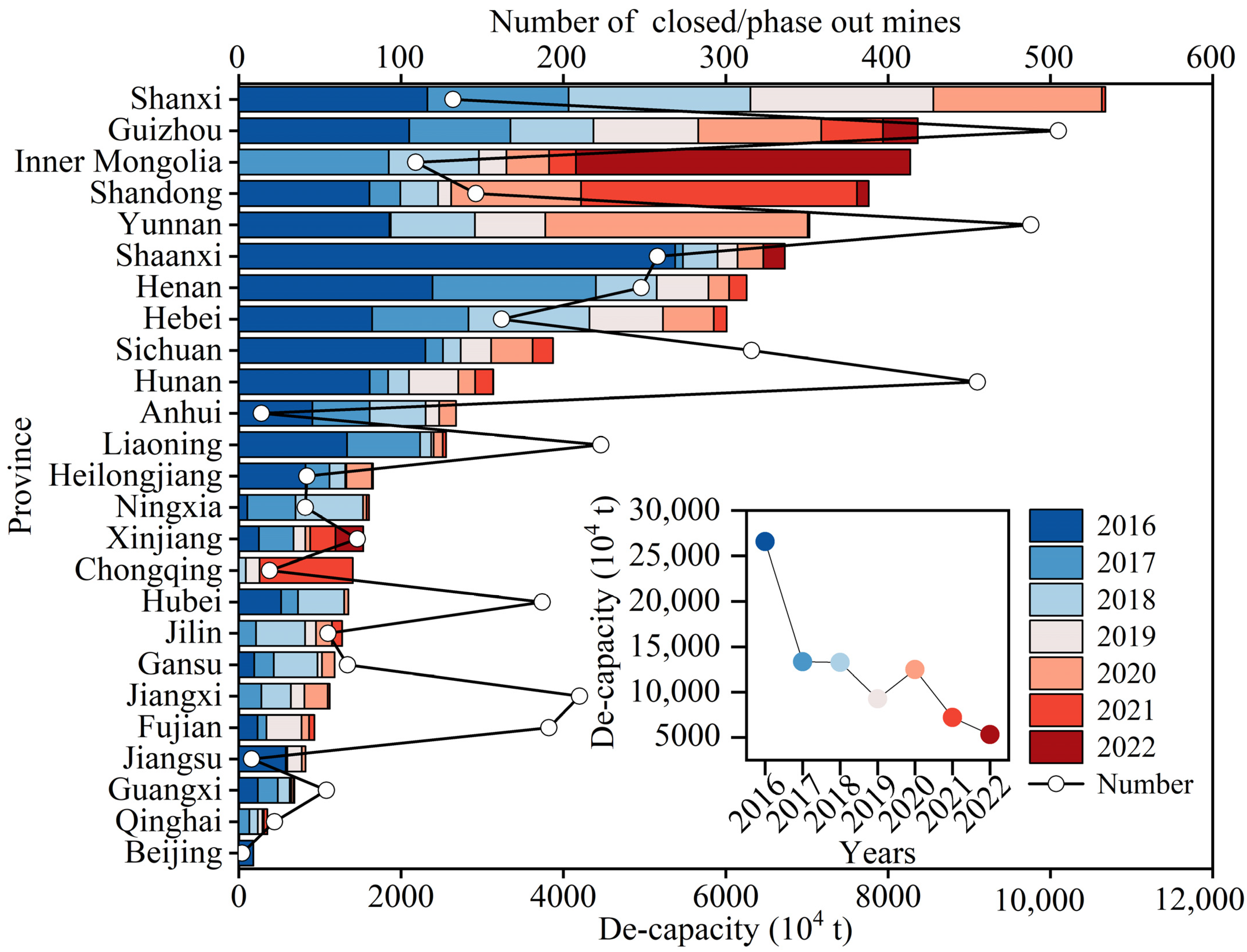
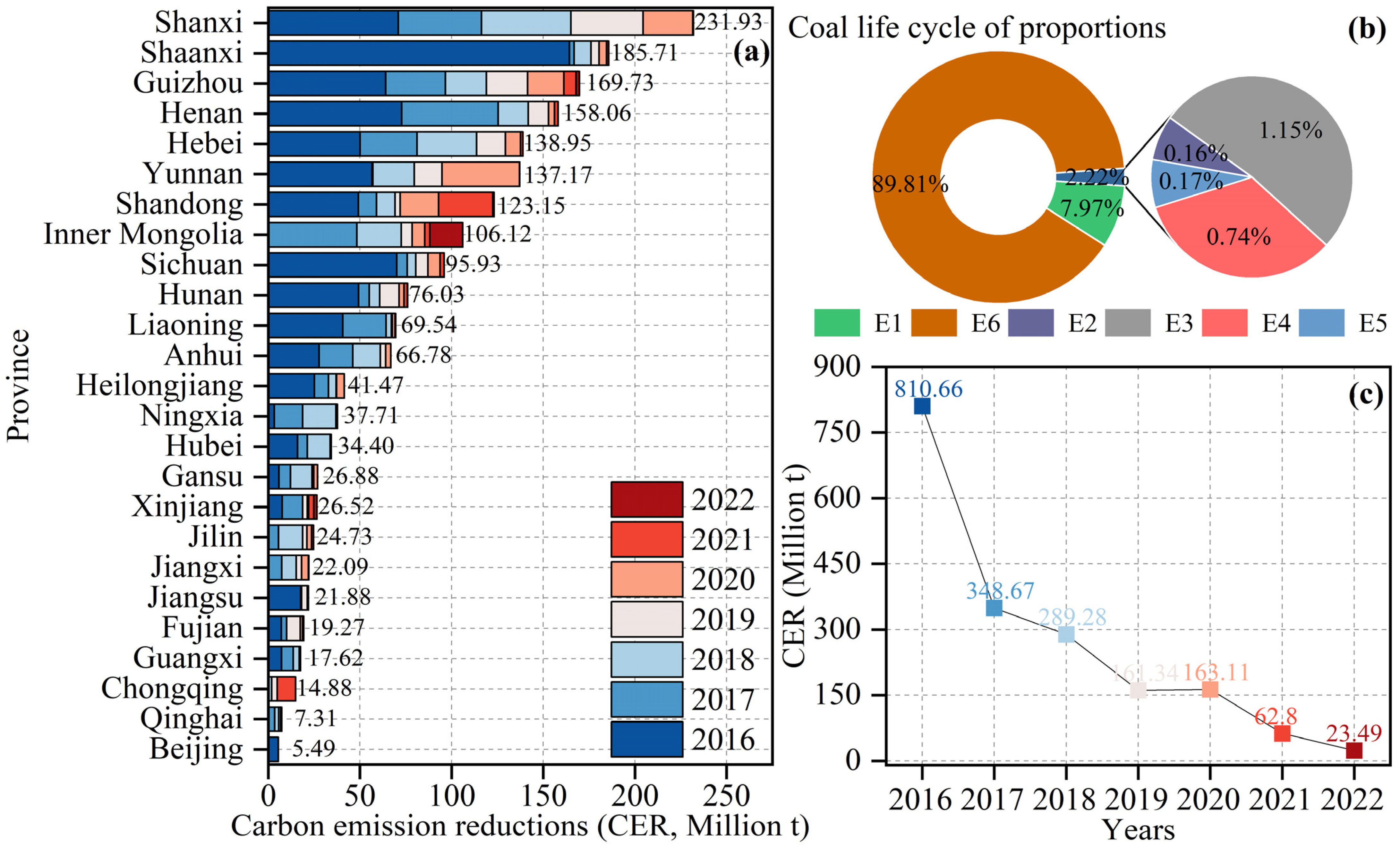
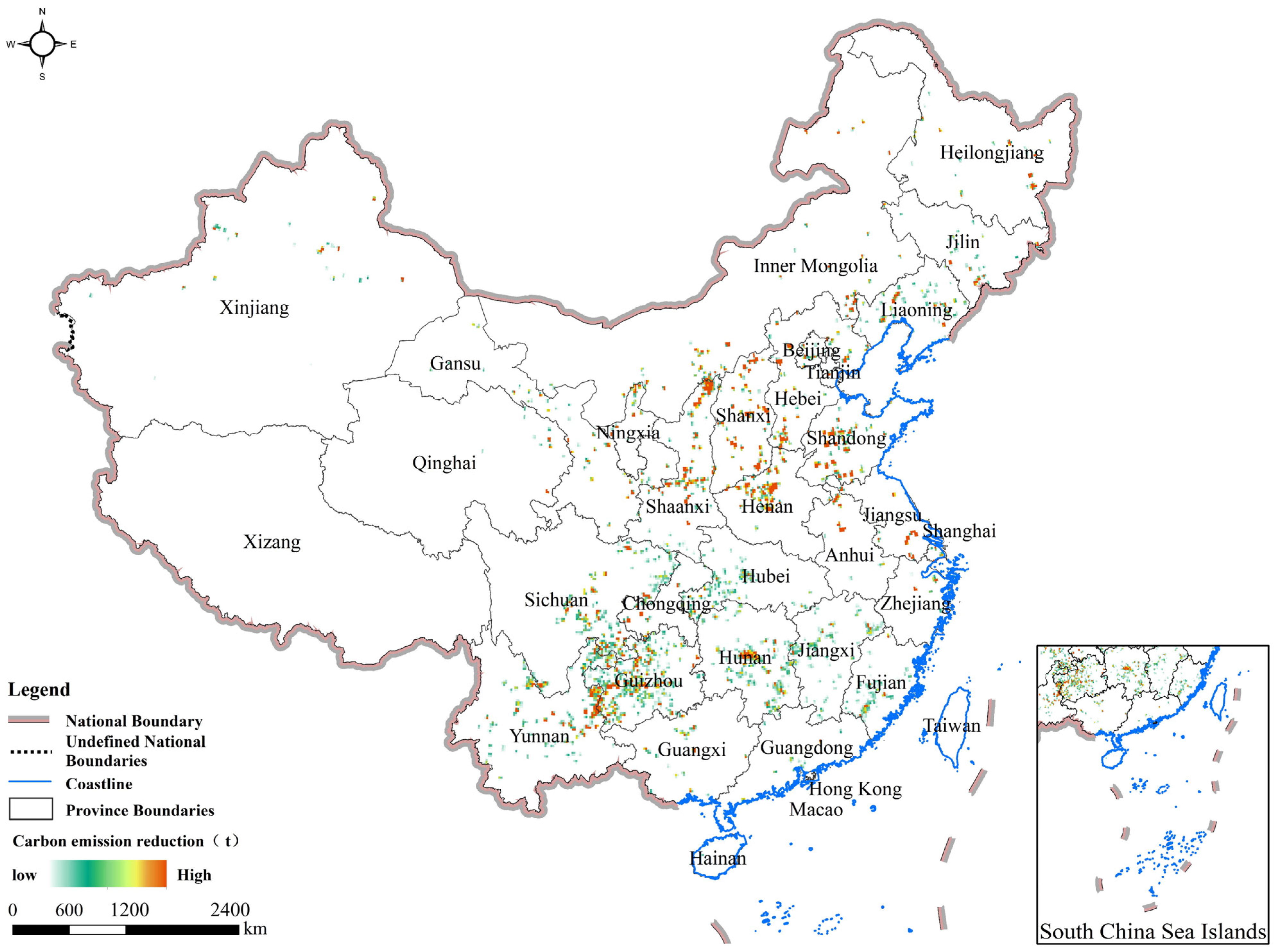
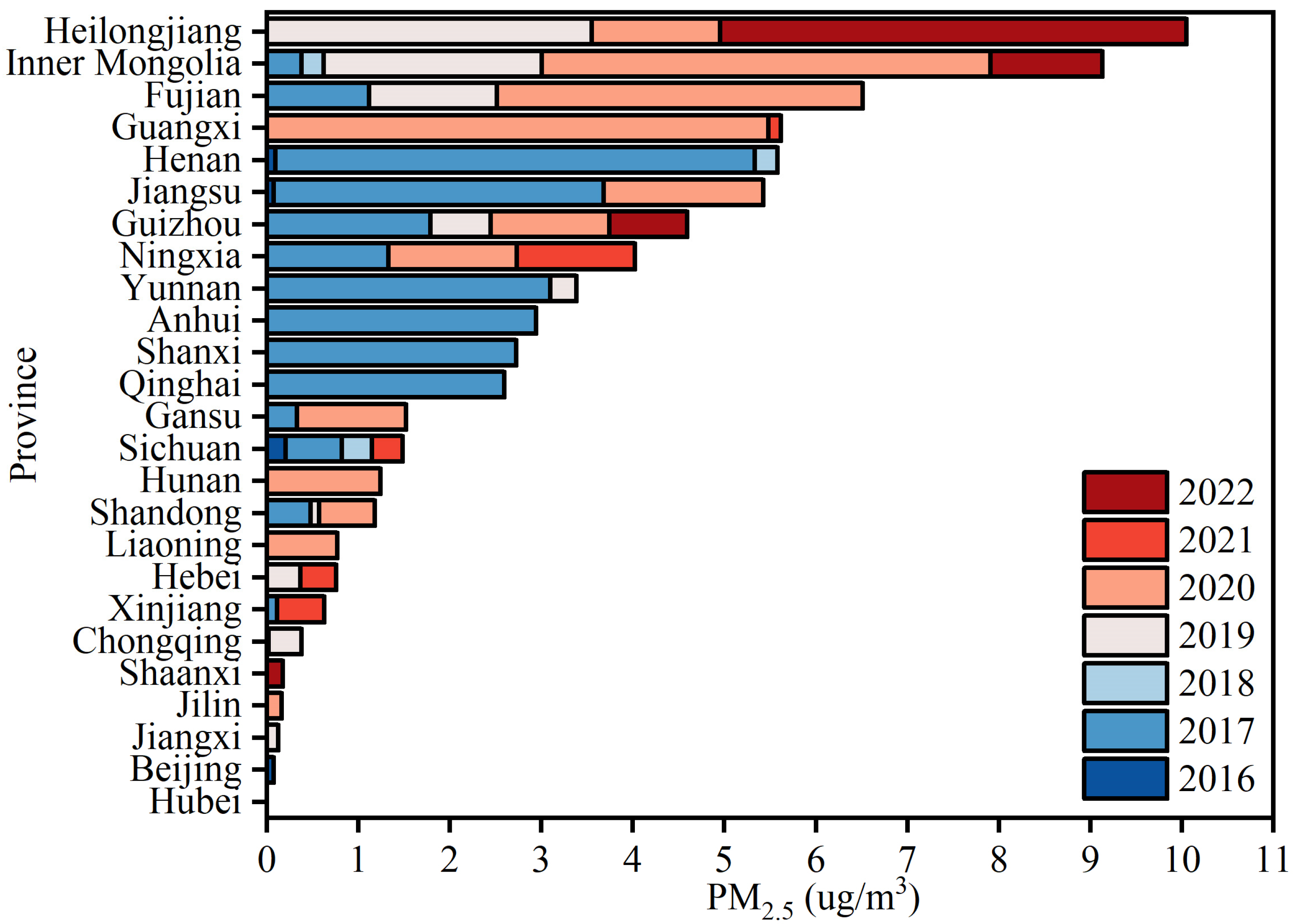

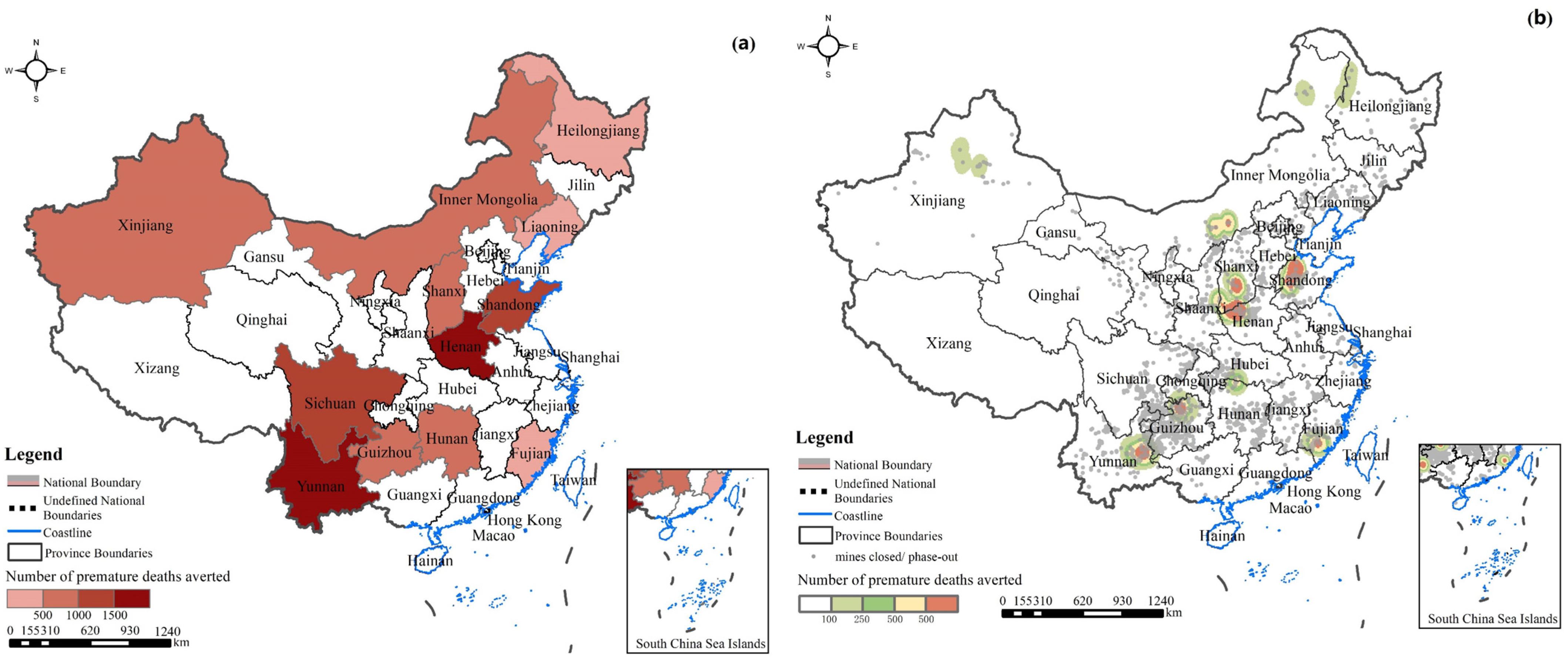

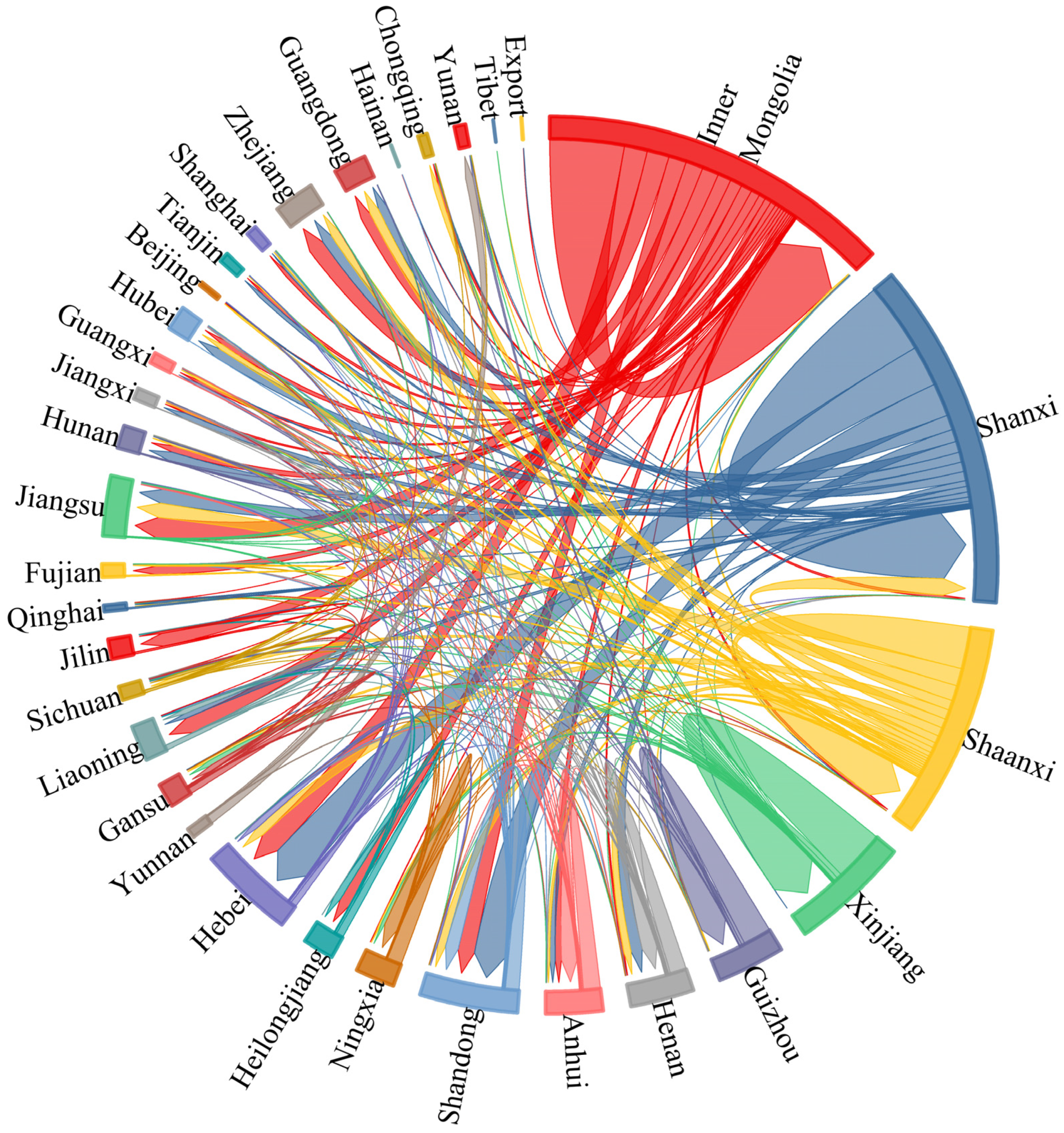
| Literatures | Policies | Coal Life Cycle | Journals |
|---|---|---|---|
| Tang et al. [26] | Ultra-low emissions standards policy in plant power | Coal utilization | Nature Energy |
| Bo et al. [27] | Ultra-low emissions standards policy in ironmaking and steelmaking | Coal utilization | Nature Sustainability |
| Tang et al. [28] | Ultra-low emissions standards policy in cement sector | Coal utilization | One Earth |
| Tibrewal et al. [29] | Biomass cooking, curbing brick production and agricultural residue burning emissions | - | Nature Sustainability |
| Tang et al. [20] | Different carbon emission reduction pathways | - | Nature Communications |
| Rauner et al. [18] | Coal-exit reductions | Coal transportation | Nature Climate Change |
| This study | Mine closures, de-capacity | Coal mining | Sustainability |
| Disease | ||||
|---|---|---|---|---|
| LC | 33.49 | 0.00005013 | 1.0128 | 7.24 |
| COPD | 29.00 | 0.00059380 | 0.6786 | 7.17 |
| Stroke | 1.01 | 0.01740000 | 1.1244 | 8.38 |
| IHD | 0.83 | 0.07170000 | 0.5516 | 6.96 |
| Years | IHD | Stroke | COPD | LC | Total |
|---|---|---|---|---|---|
| 2017 | 4336.08 | 631.75 | 563.52 | 52.41 | 5583.76 |
| 2020 | 3692.82 | 1286.69 | 544.35 | 61.15 | 5585.01 |
| 2021 | 23.58 | 0.13 | 2.02 | 0.11 | 25.84 |
| 2022 | 264.34 | 240.75 | 67.98 | 7.17 | 580.24 |
| Total | 8316.82 | 2159.32 | 1177.87 | 120.84 | 11,774.85 |
| Province | 2017 | 2020 | 2021 | 2022 | Total |
|---|---|---|---|---|---|
| Henan | 3017.77 | 0.00 | 0.00 | 0.00 | 3017.77 |
| Yunnan | 0.00 | 1577.64 | 0.00 | 0.00 | 1577.64 |
| Shandong | 0.00 | 1179.42 | 0.00 | 0.00 | 1179.42 |
| Sichuan | 0.00 | 1118.03 | 0.00 | 0.00 | 1118.03 |
| Hunan | 320.34 | 654.13 | 0.00 | 0.00 | 974.47 |
| Inner Mongolia | 0.00 | 846.08 | 0.00 | 72.24 | 918.32 |
| Guizhou | 885.04 | 0.00 | 0.00 | 0.00 | 885.04 |
| Shanxi | 872.81 | 0.00 | 0.00 | 0.00 | 872.81 |
| Xinjiang | 39.17 | 0.00 | 25.84 | 508.00 | 573.01 |
| Liaoning | 338.79 | 0.00 | 0.00 | 0.00 | 338.79 |
| Fujian | 109.84 | 181.66 | 0.00 | 0.00 | 291.50 |
| Heilongjiang | 0.00 | 28.05 | 0.00 | 0.00 | 28.05 |
| Total | 5583.76 | 5585.01 | 25.84 | 580.24 | 11,774.86 |
Disclaimer/Publisher’s Note: The statements, opinions and data contained in all publications are solely those of the individual author(s) and contributor(s) and not of MDPI and/or the editor(s). MDPI and/or the editor(s) disclaim responsibility for any injury to people or property resulting from any ideas, methods, instructions or products referred to in the content. |
© 2023 by the authors. Licensee MDPI, Basel, Switzerland. This article is an open access article distributed under the terms and conditions of the Creative Commons Attribution (CC BY) license (https://creativecommons.org/licenses/by/4.0/).
Share and Cite
Cui, G.; Lu, S.; Dong, D.; Zhao, Y. Co-Benefits Analysis of Coal De-Capacity in China. Sustainability 2024, 16, 115. https://doi.org/10.3390/su16010115
Cui G, Lu S, Dong D, Zhao Y. Co-Benefits Analysis of Coal De-Capacity in China. Sustainability. 2024; 16(1):115. https://doi.org/10.3390/su16010115
Chicago/Turabian StyleCui, Guangyuan, Shuang Lu, Donglin Dong, and Yanan Zhao. 2024. "Co-Benefits Analysis of Coal De-Capacity in China" Sustainability 16, no. 1: 115. https://doi.org/10.3390/su16010115





